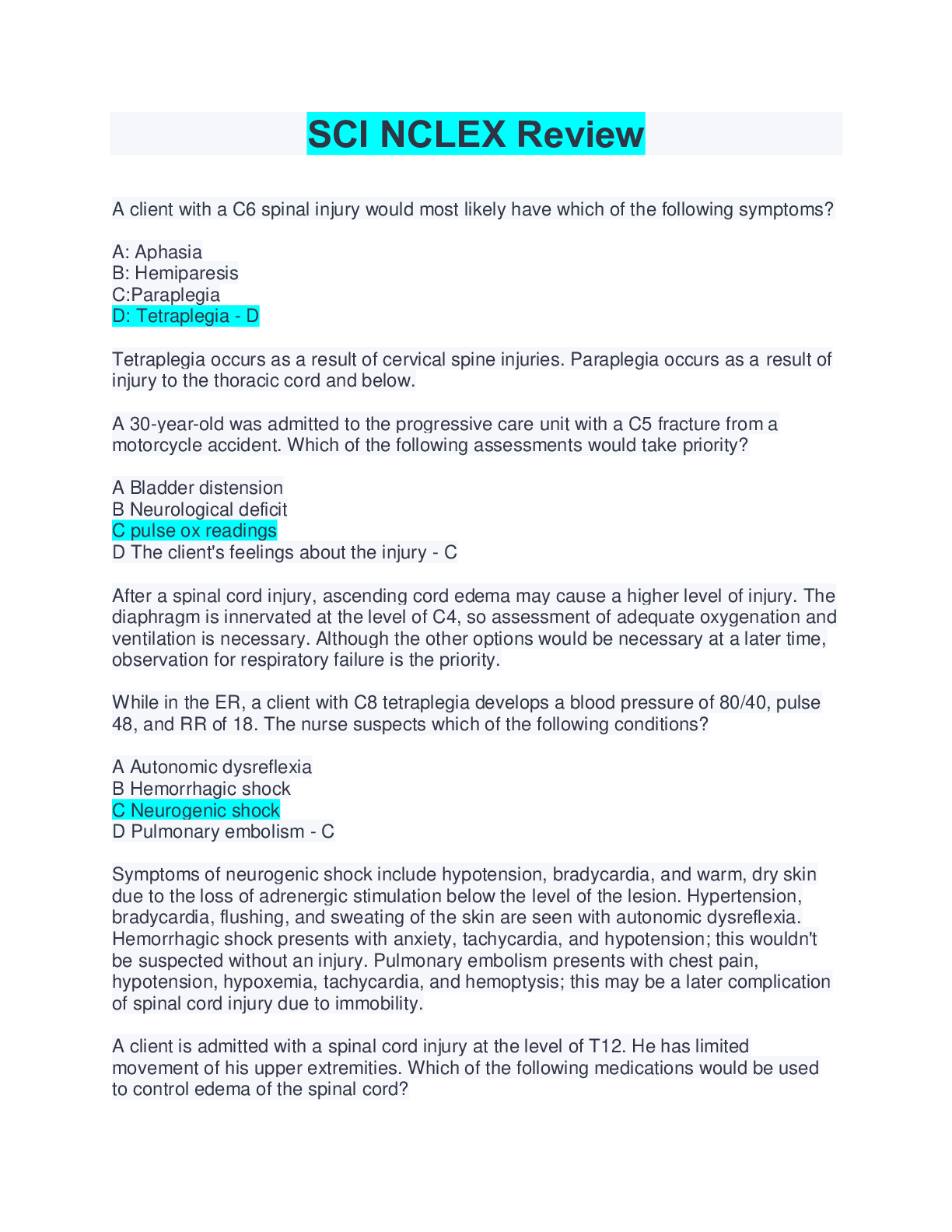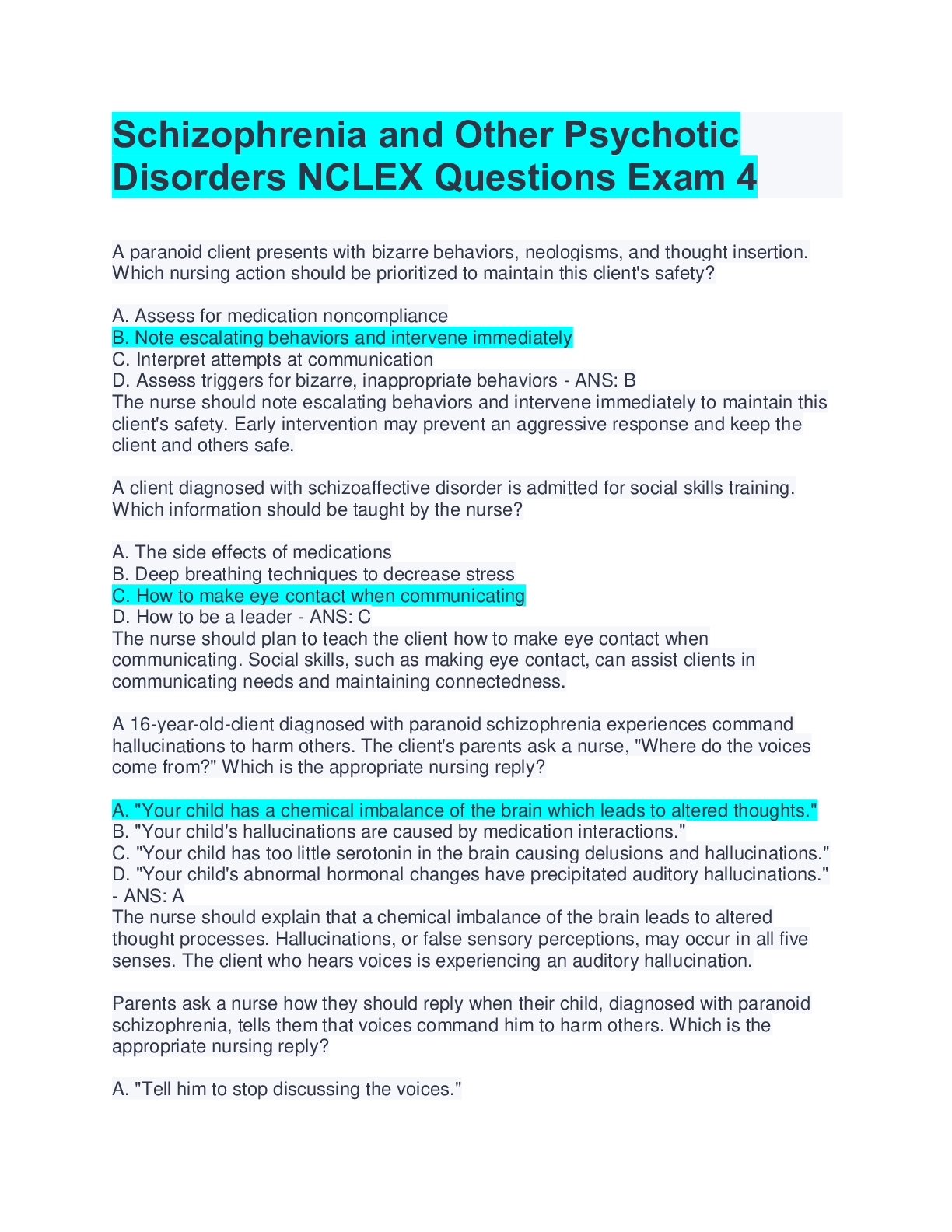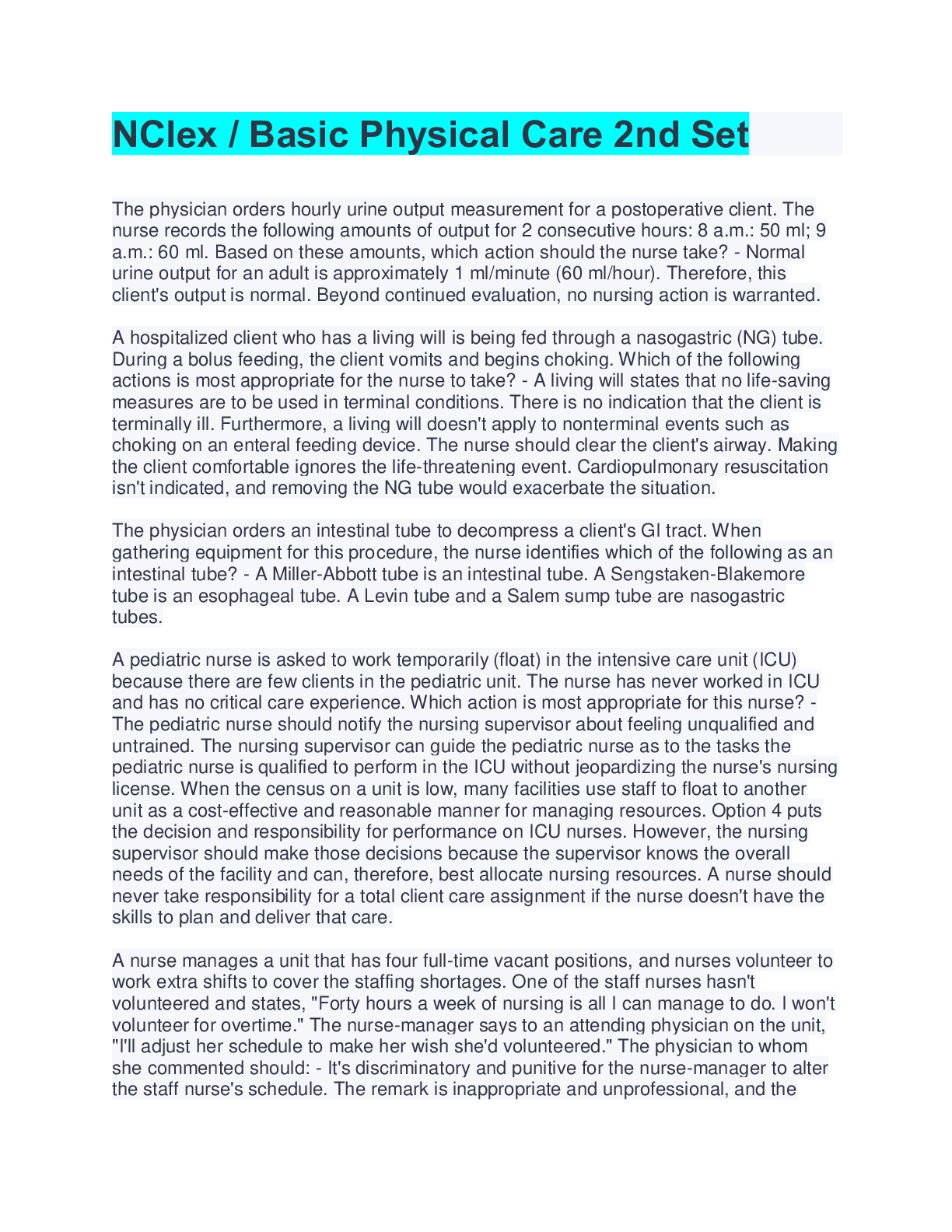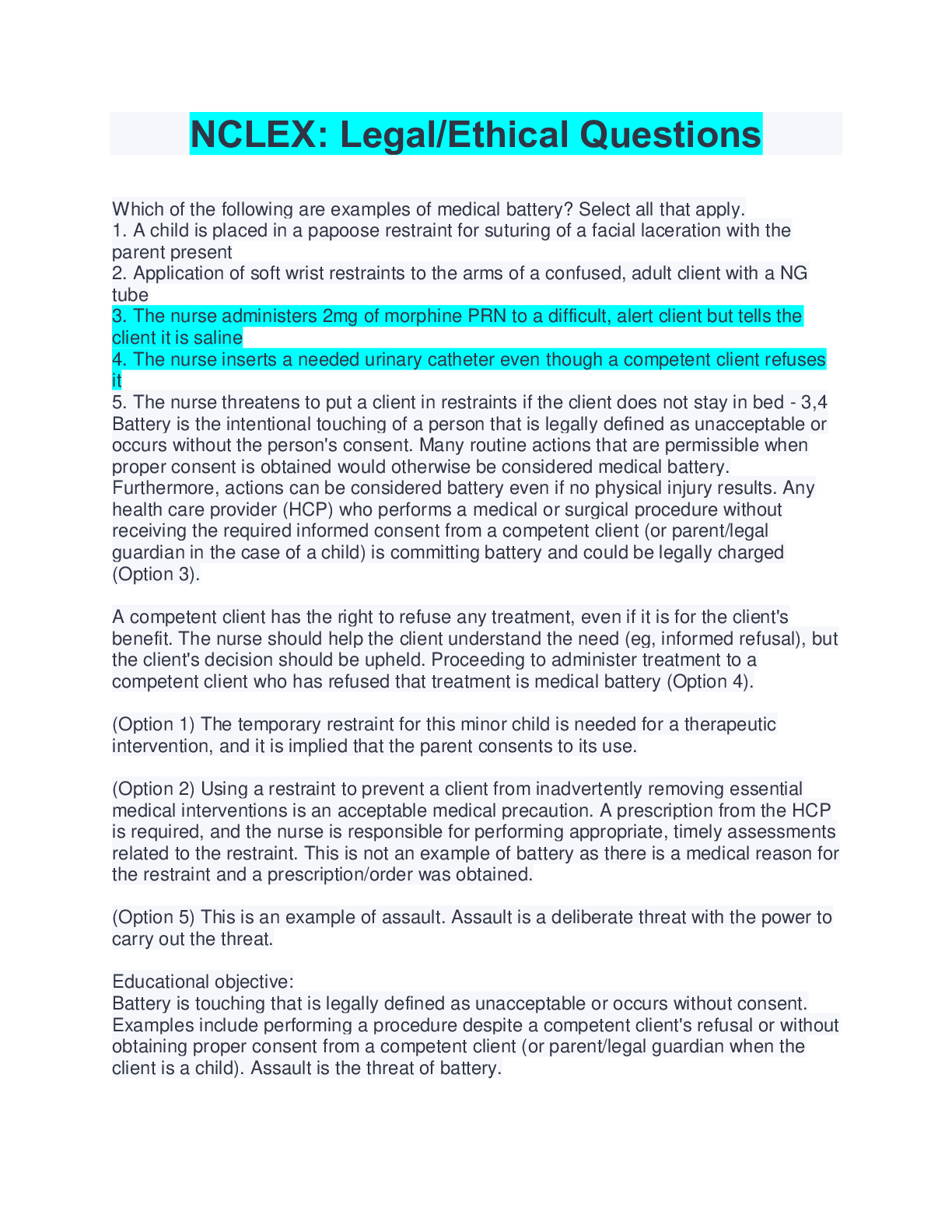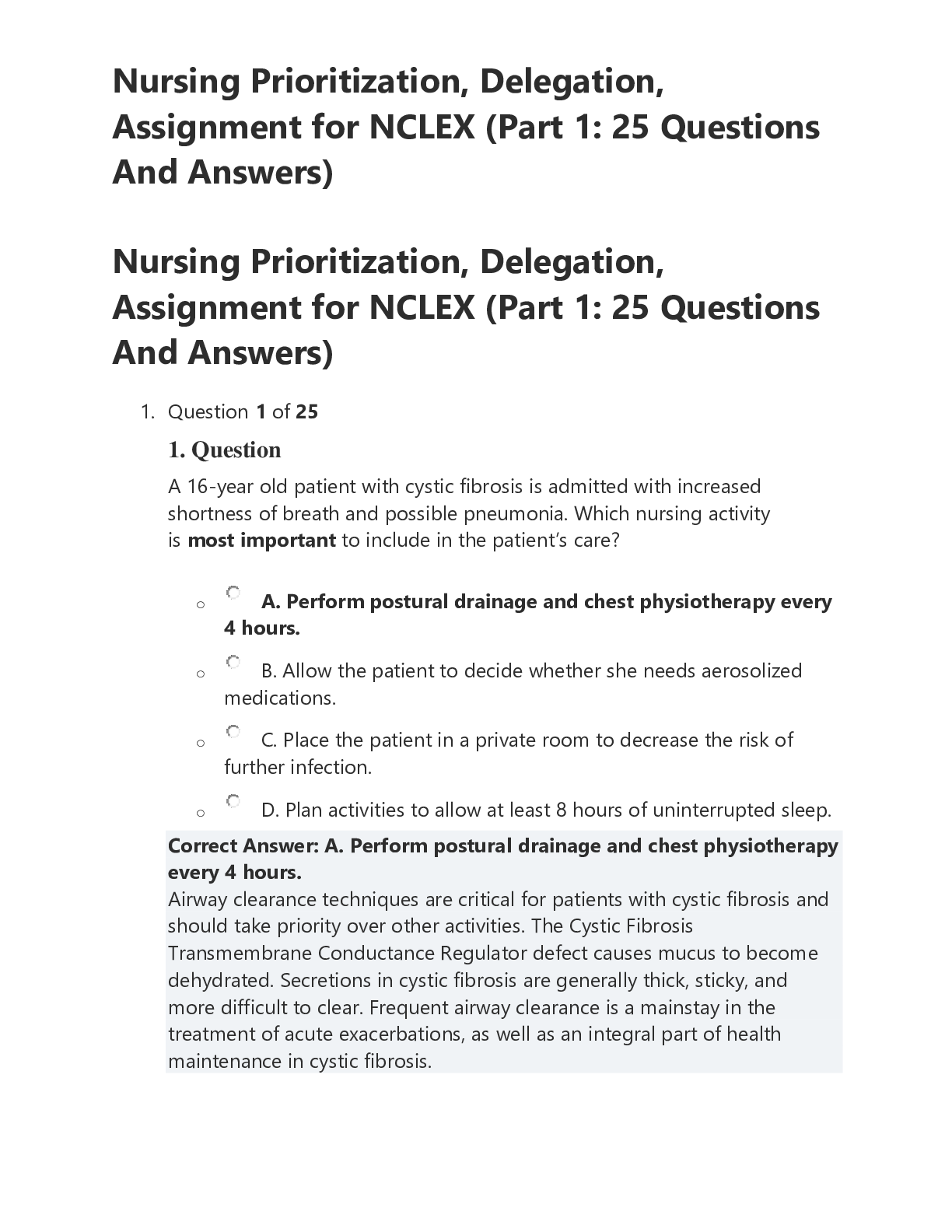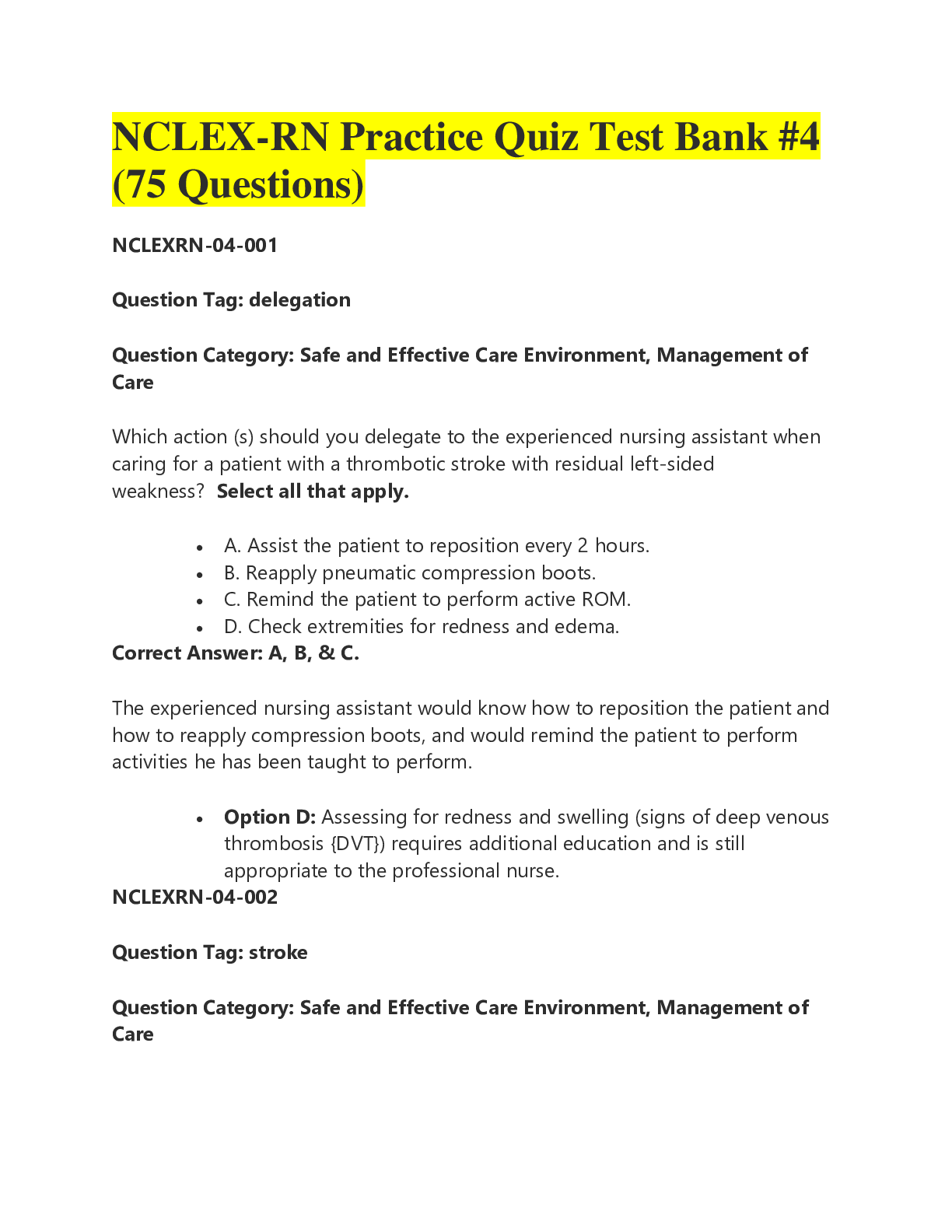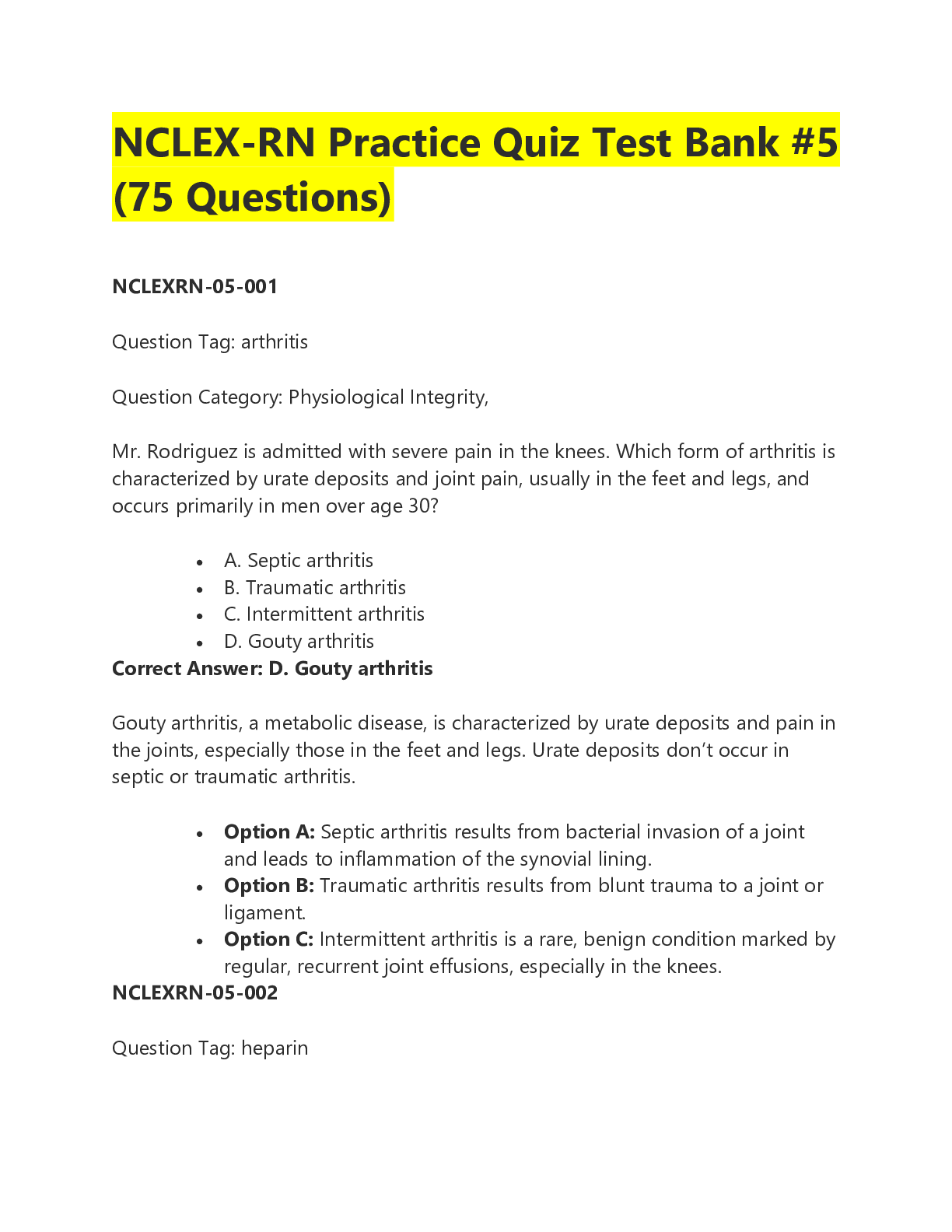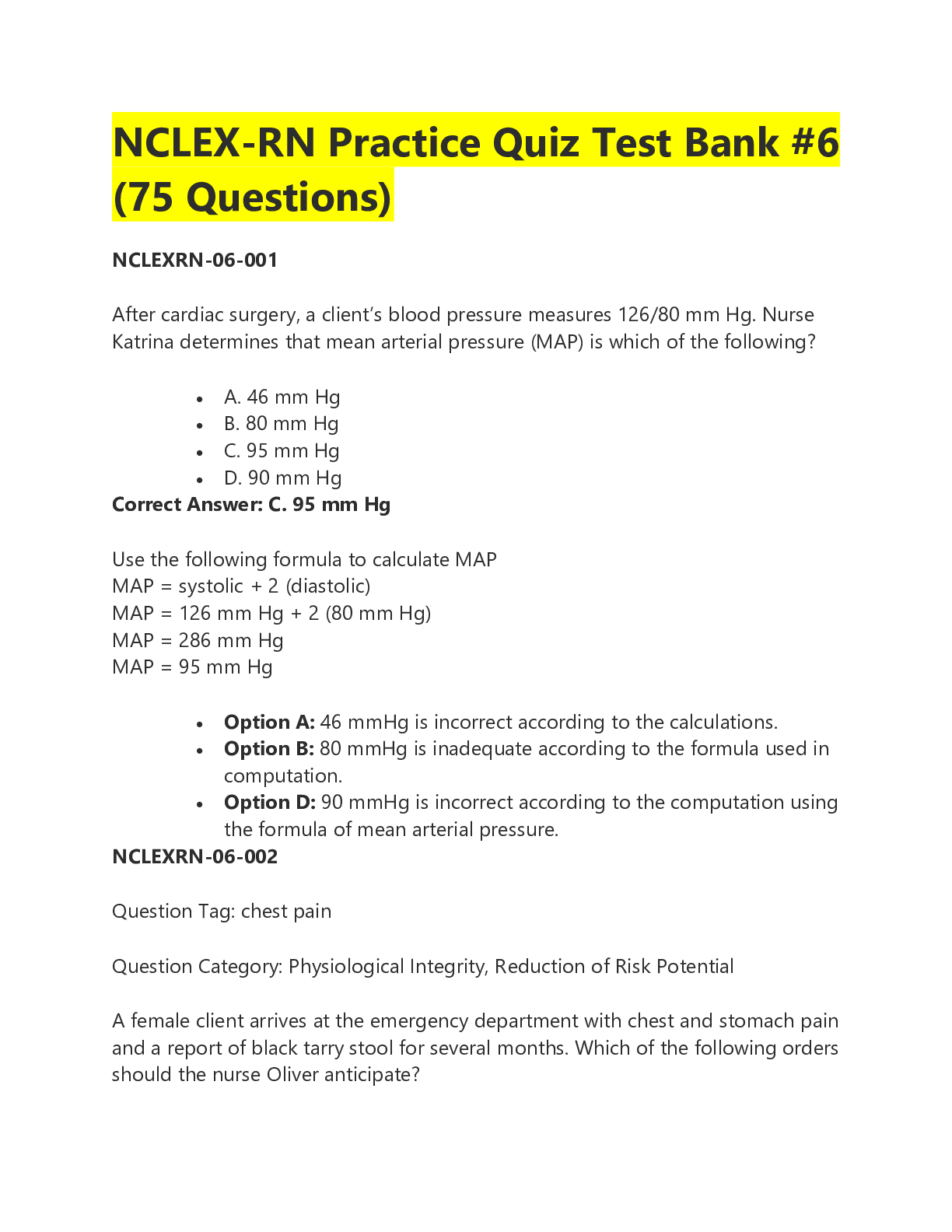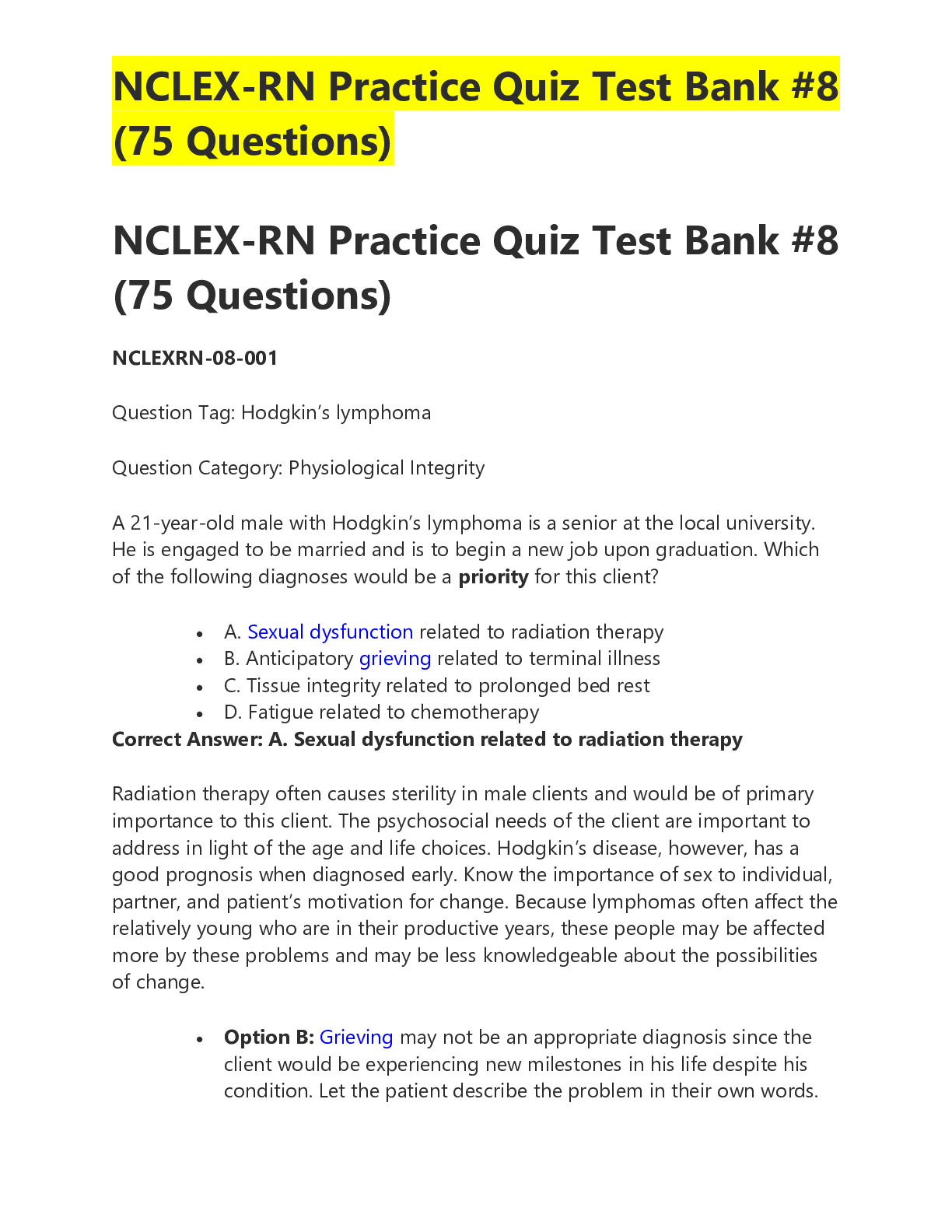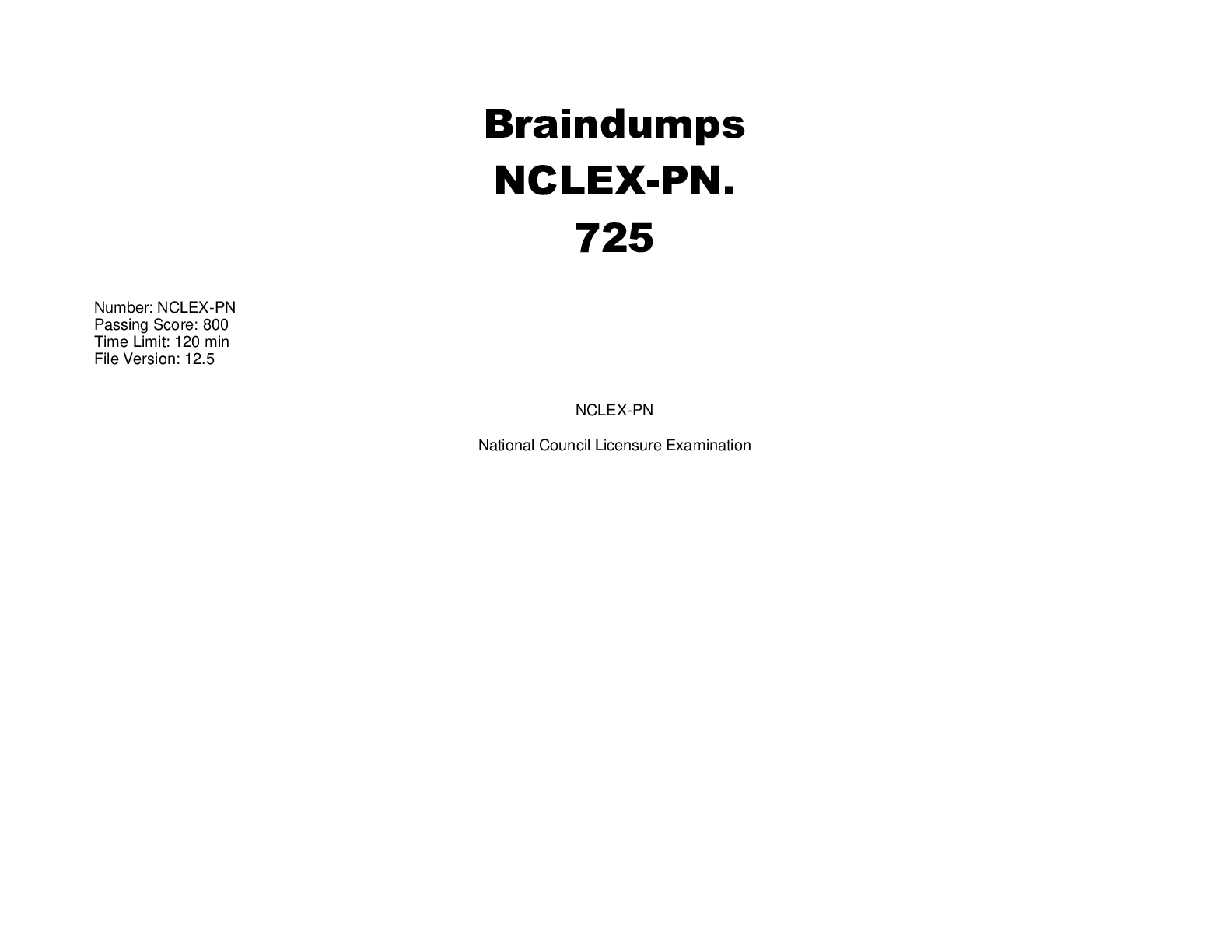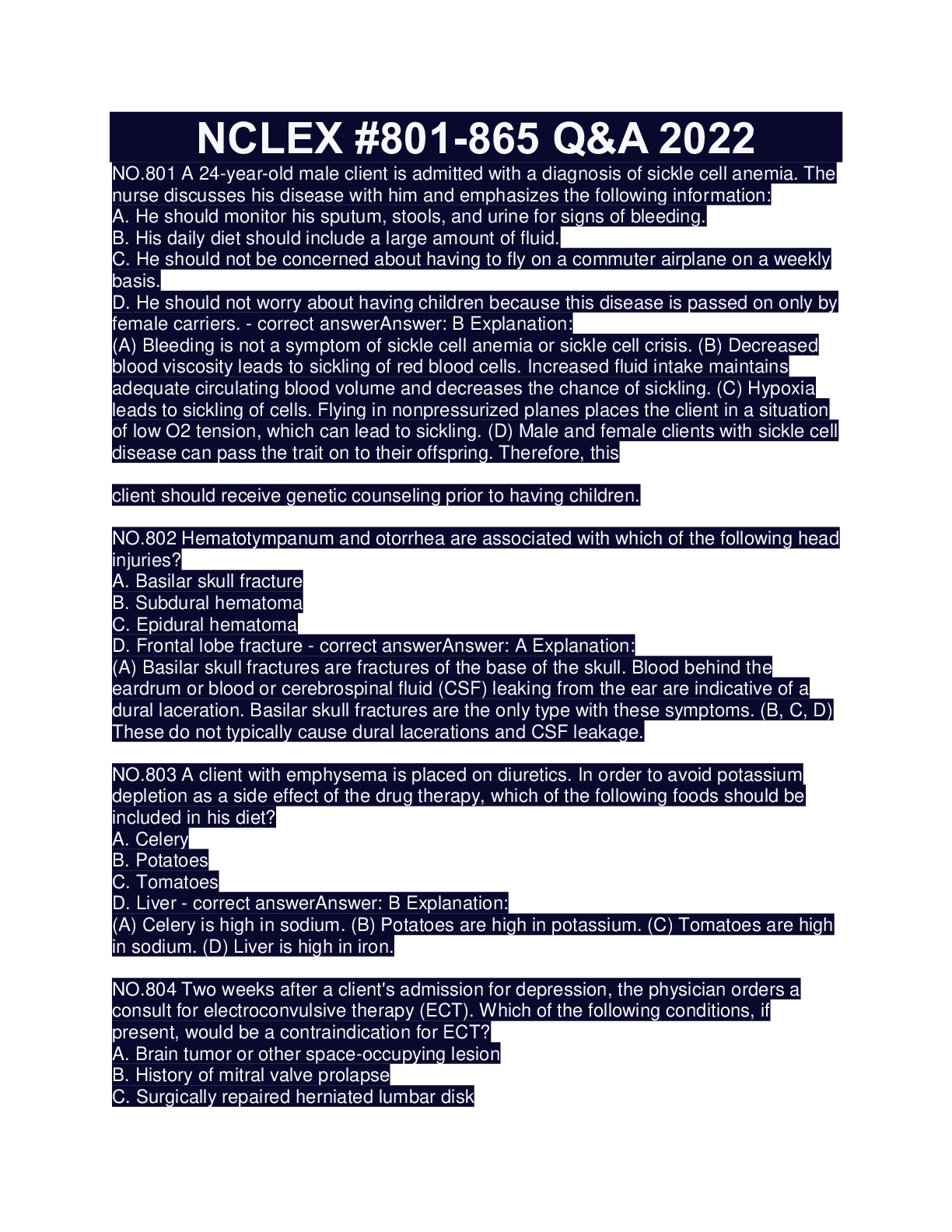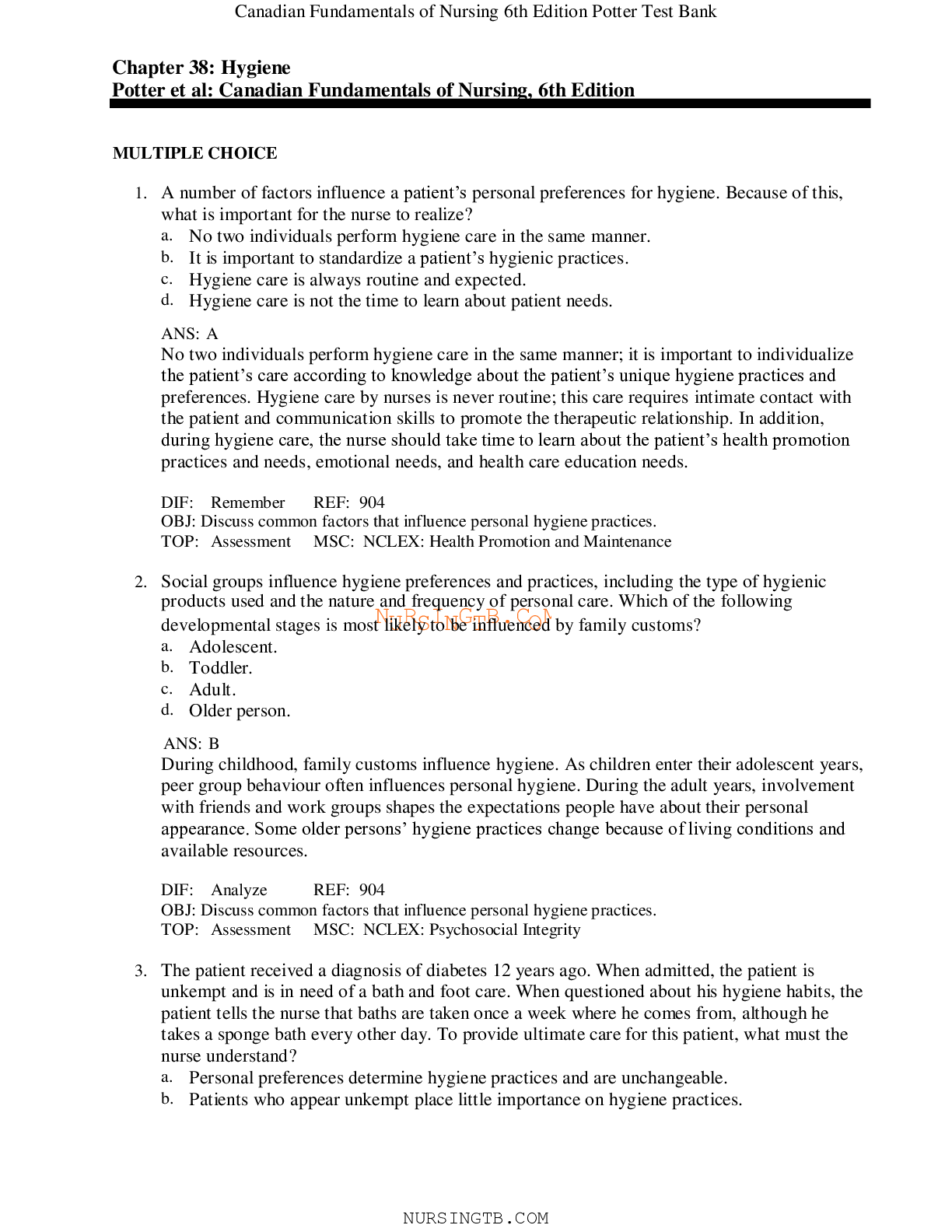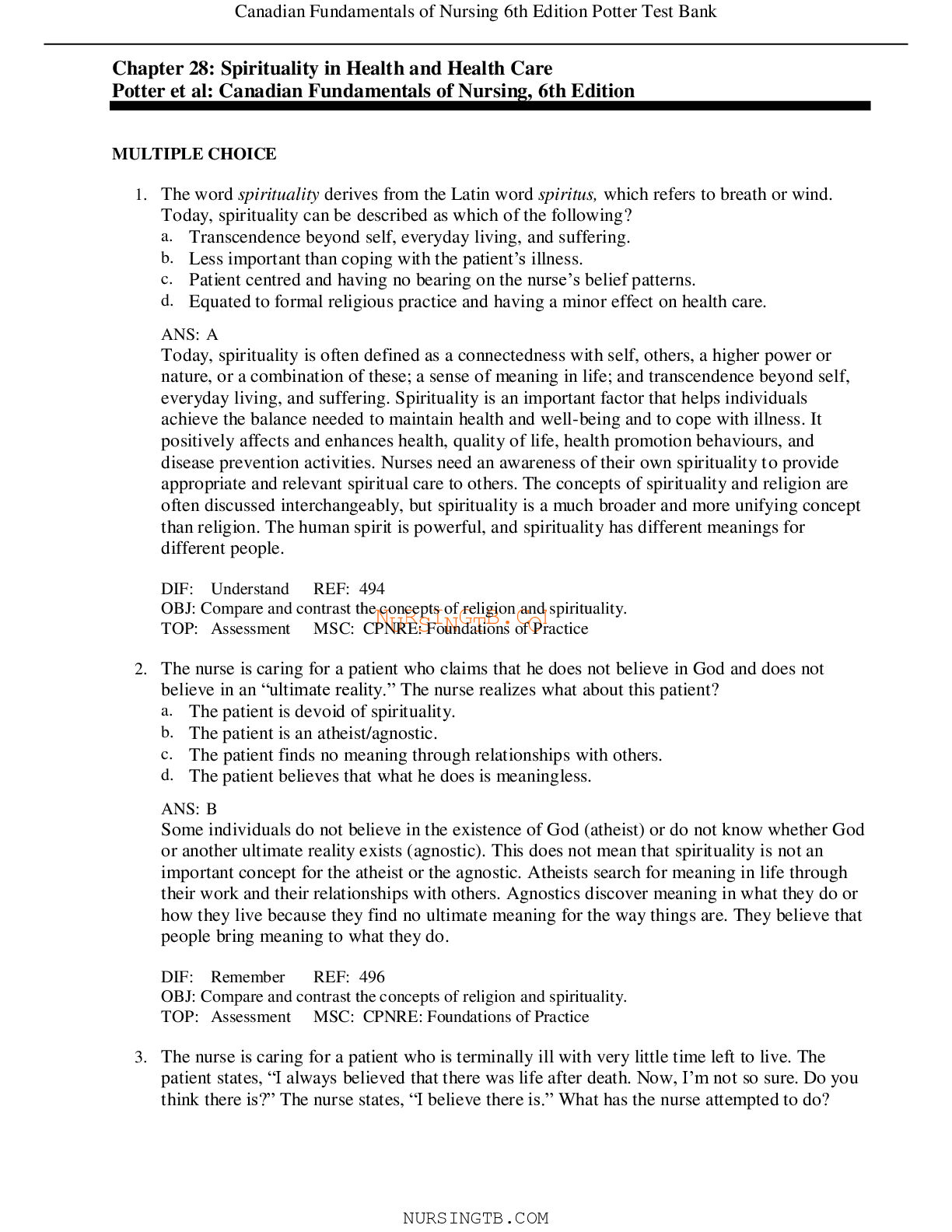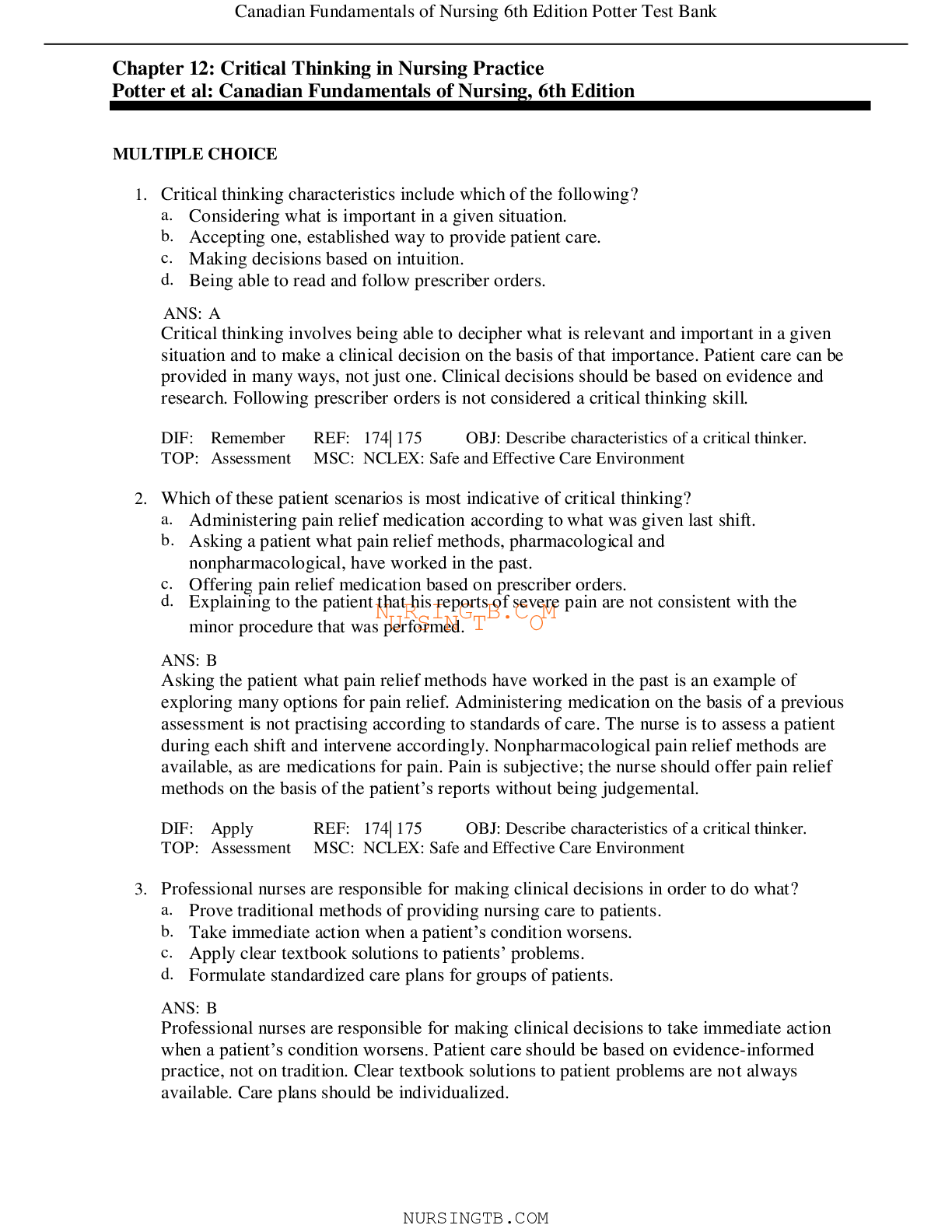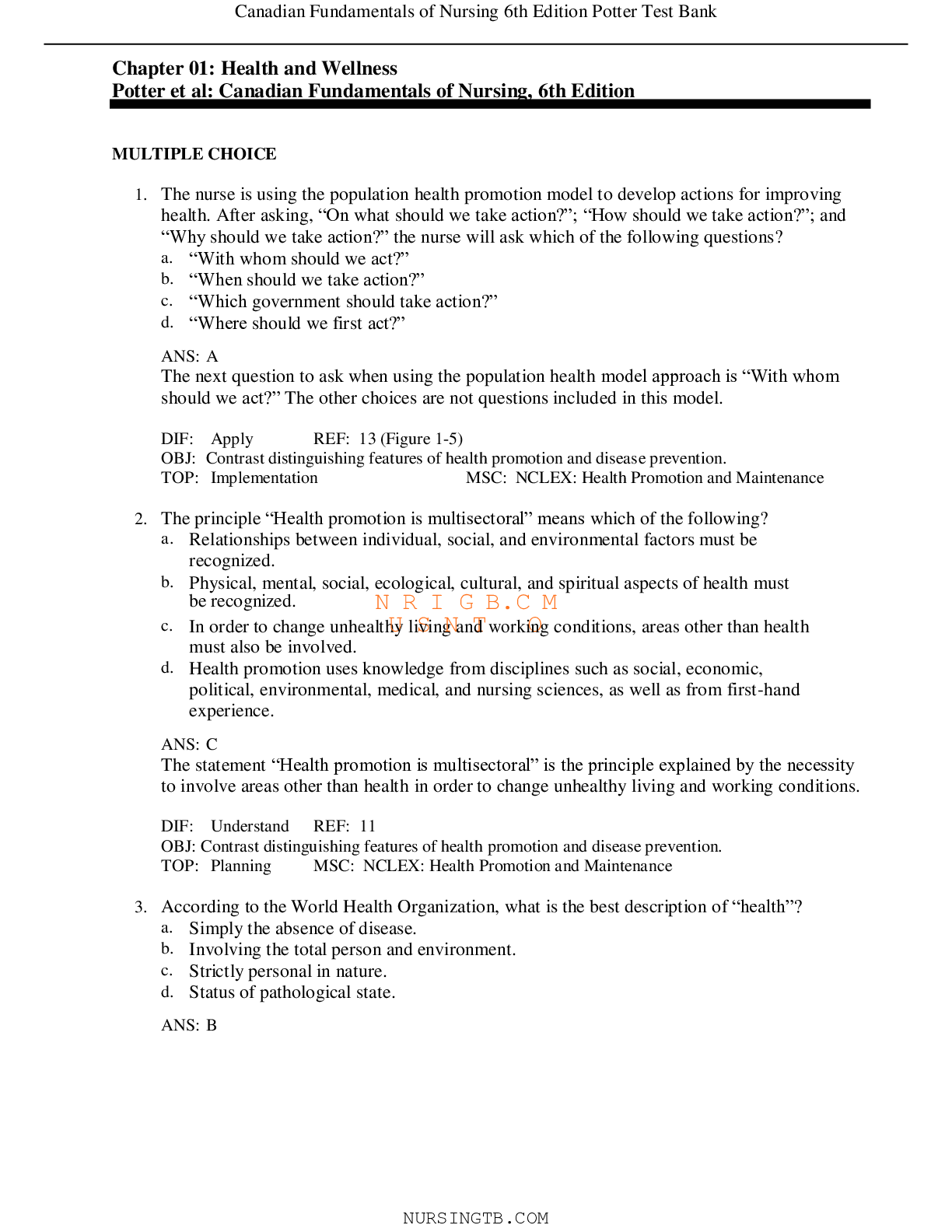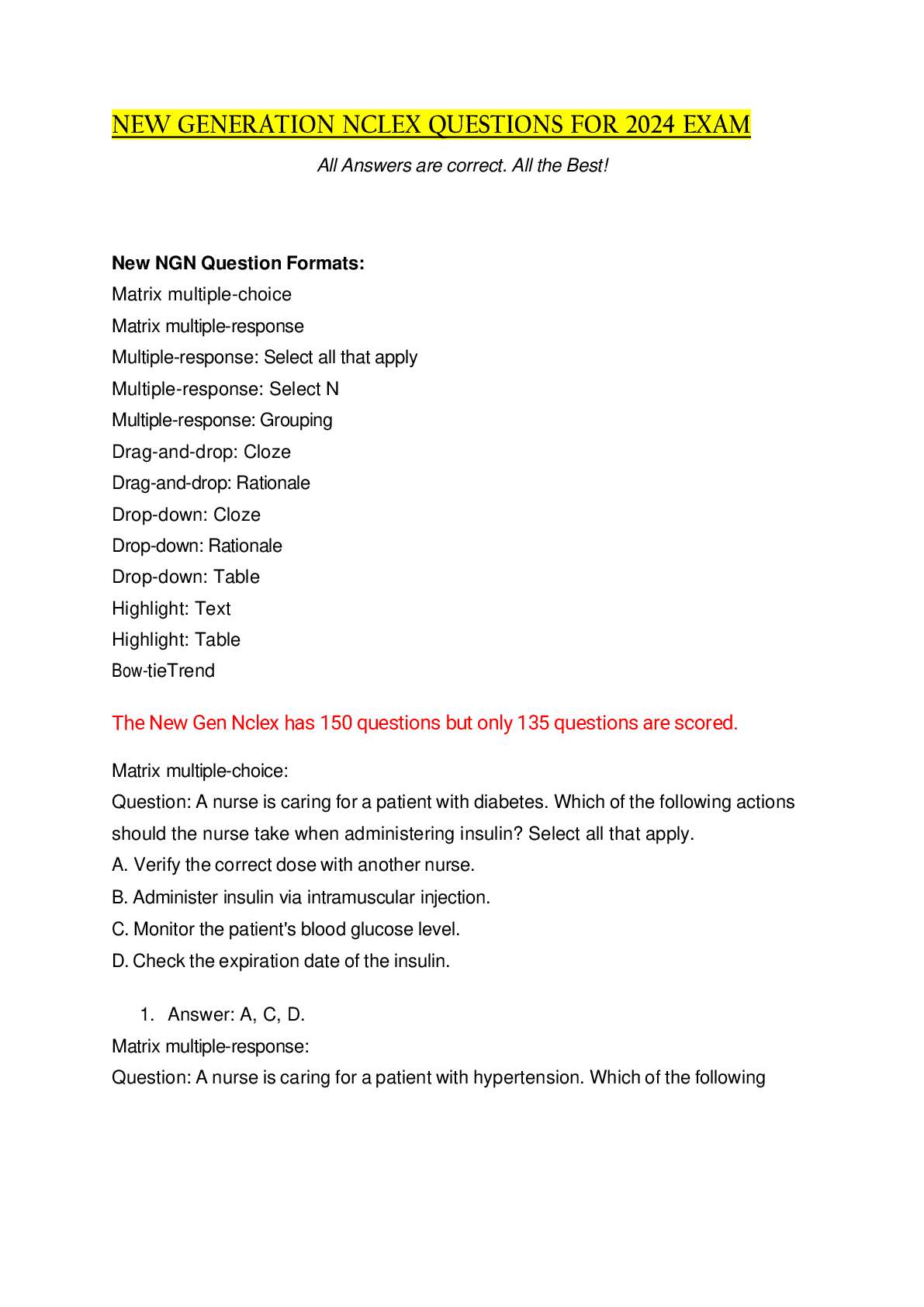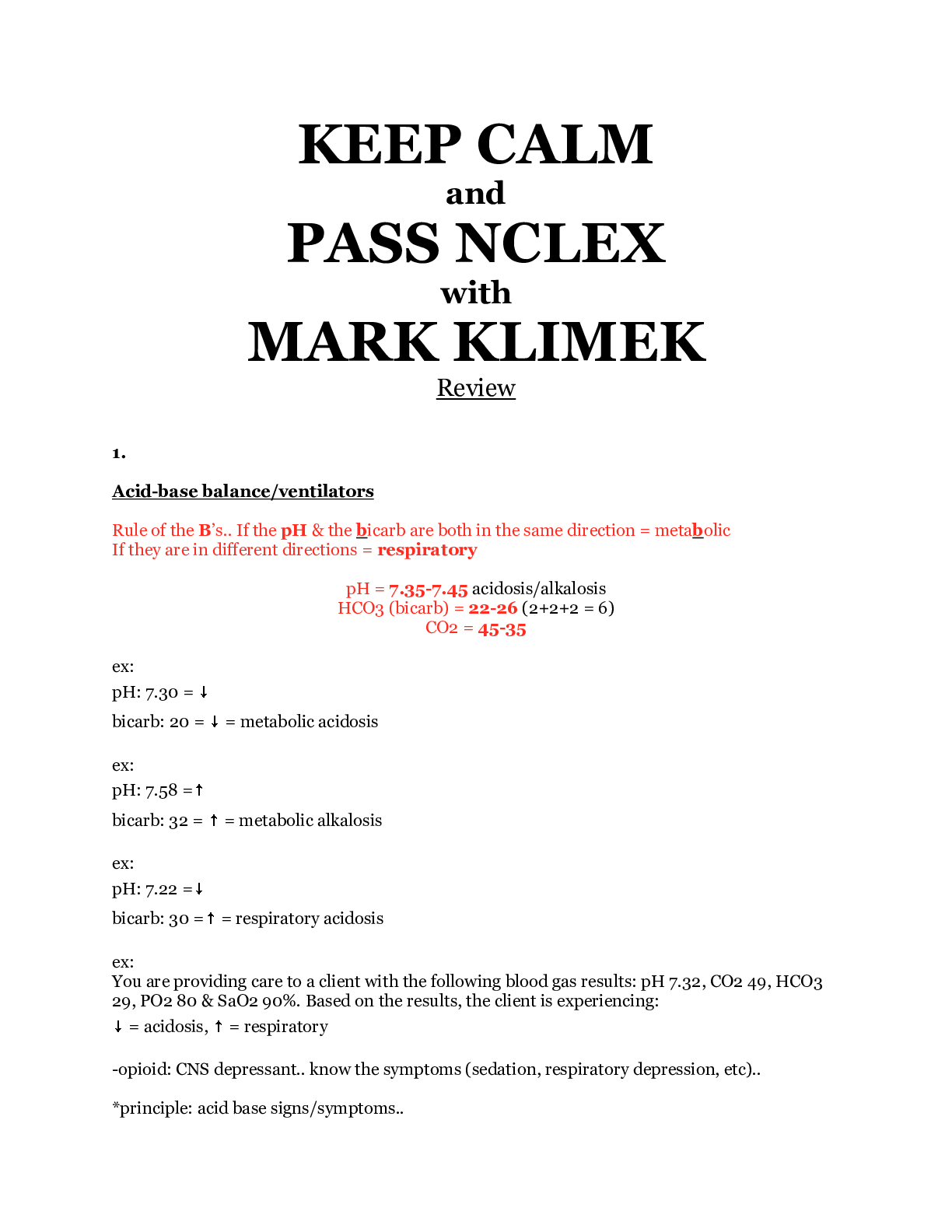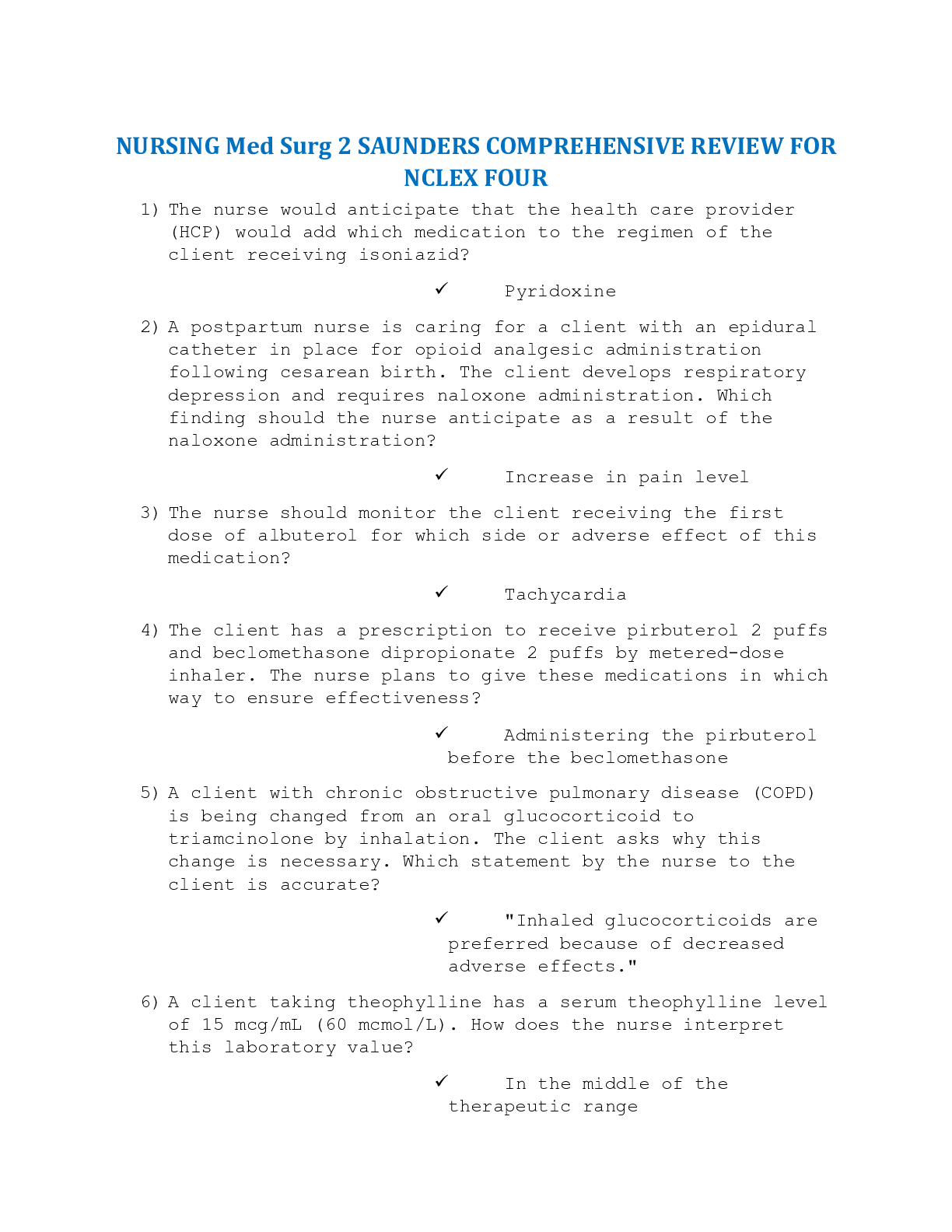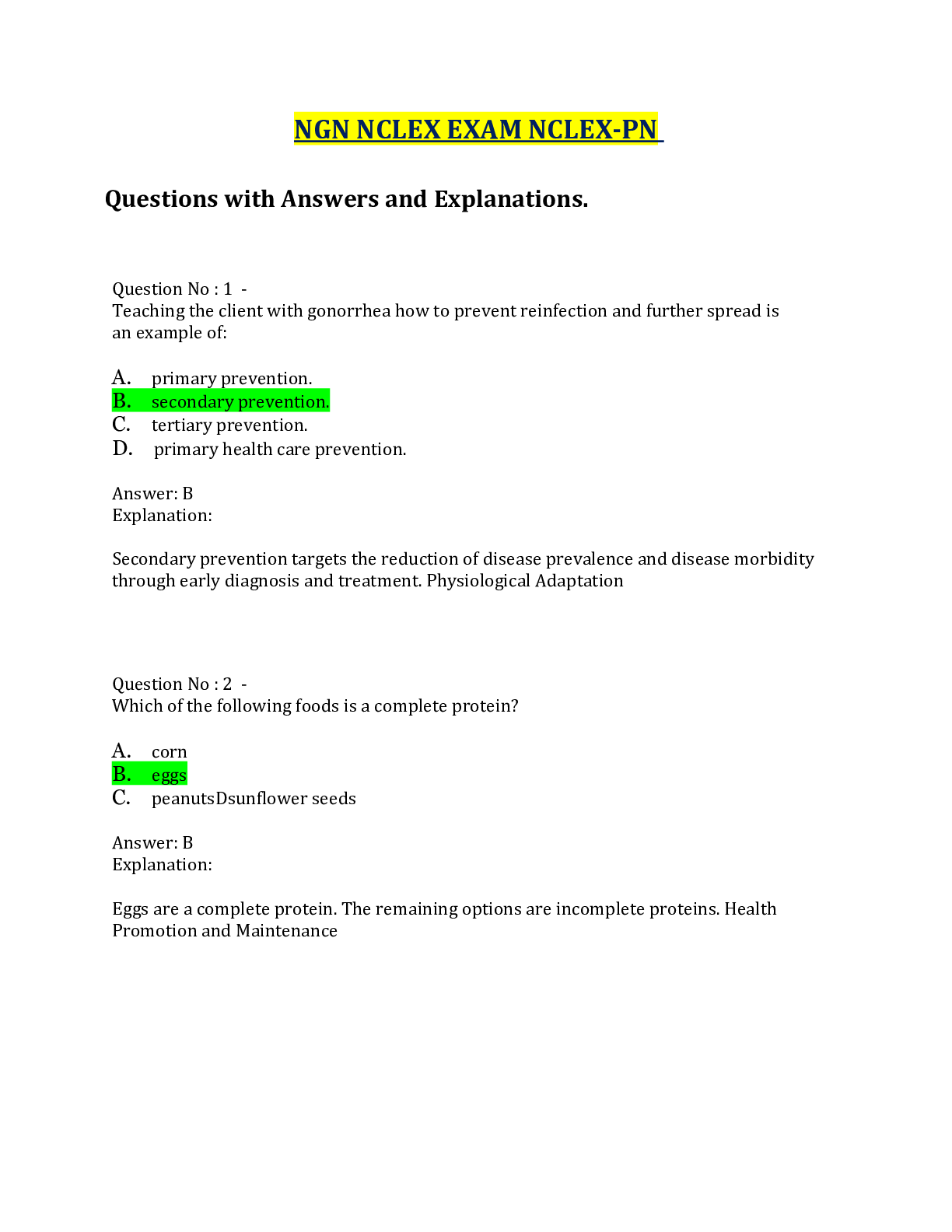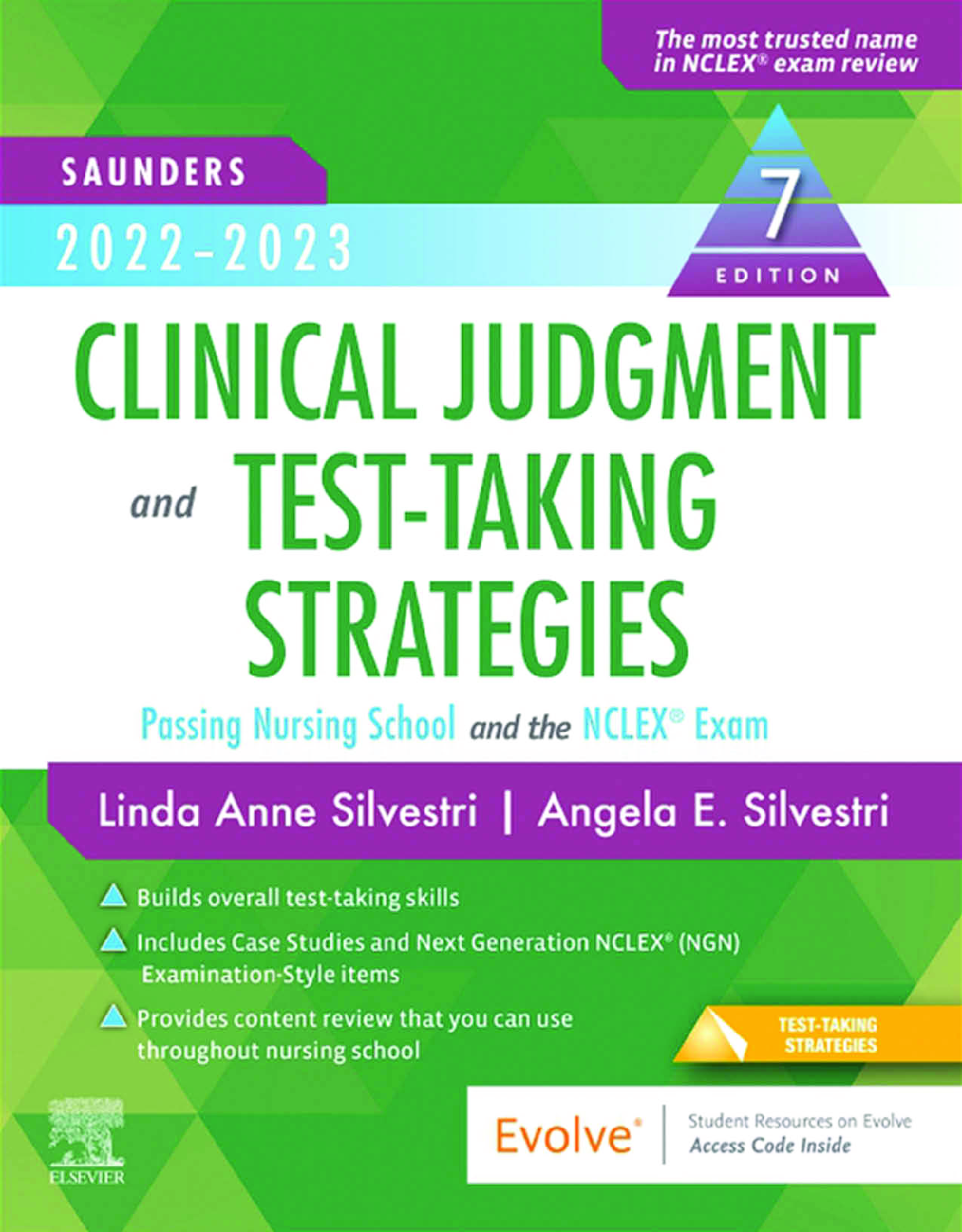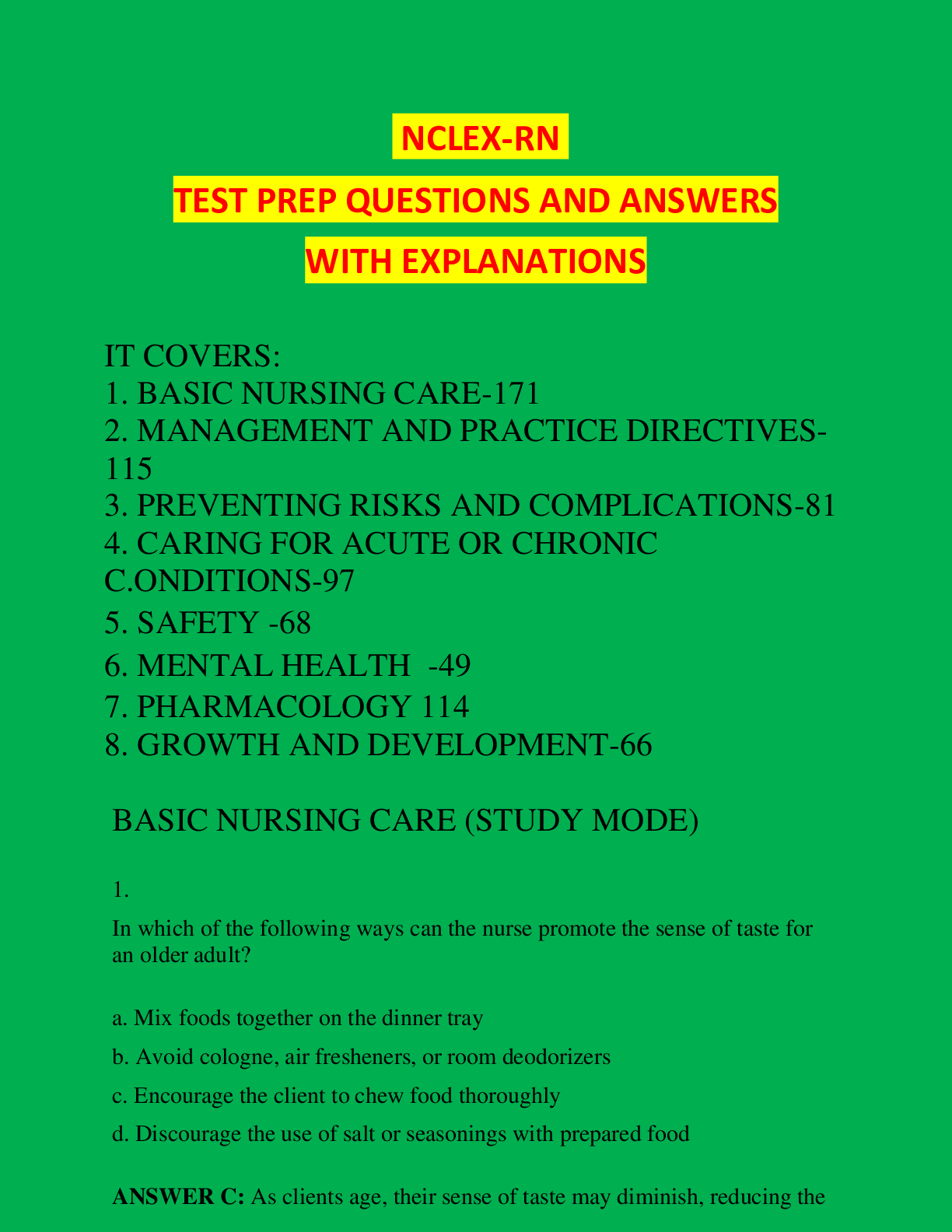Canadian Fundamentals of Nursing, 6th Edition/Chapter 30: Vital Signs
Document Content and Description Below
Chapter 30: Vital Signs Potter et al: Canadian Fundamentals of Nursing, 6th Edition MULTIPLE CHOICE 1. How does the posterior hypothalamus help control temperature? 2. Of the following me... chanisms of heat loss by the body, identify the mechanism that transfers heat away by using air movement? 3. The patient has a temperature of 40.7°C (105.2°F). The nurse is attempting to lower his temperature by providing tepid sponge baths and placing cool compresses in strategic body locations. The nurse is attempting to lower the patient’s temperature through the use of which of the following? 4. When focusing on temperature regulation of newborns and infants, what should the nurse know? .COM 5. The nurse working the night shift on a surgical unit is making rounds at 0400 hours. She notices that the patient’s temperature is 36°C (96.8°F), whereas at 1600 hours the preceding day, it was 37°C (98.6°F). What should the nurse do? 6. The nurse is caring for a patient who has a temperature reading of 38°C (100.4°F). His last two temperature readings were 37°C (98.6°F) and 36°C (96.8°F). The nurse should 7. When heat loss mechanisms of the body are unable to keep pace with excess heat production, the result is known as 8. The nurse is caring for a patient who has an elevated temperature. What should the nurse know? respirations, and blood pressure. TOP: Assessment MSC: NCLEX: Physiological Integrity 9. The patient is restless and has a temperature of 39°C (102.2°F). What is one of the first things the nurse should do? a. Place the patient on oxygen. b. Restrict fluid intake. c. Increase patient activity. d. Increase patient’s metabolic rate. ANS: A During a fever, cellular metabolism increases, and oxygen consumption rises. Myocardial hypoxia produces angina. Cerebral hypoxia produces confusion. Interventions during a fever include oxygen therapy. Dehydration is a serious problem through increased respiration and diaphoresis, and a dehydrated patient is at risk for fluid volume deficit. Fluids should not be restricted. Increasing activity would increase the metabolic rate further, which would not be advisable. DIF: Apply REF: 531 OBJ: Describe factors that cause variations in body temperature, pulse, oxygen saturation, respirations, and blood pressure. TOP: Implementation MSC: NCLEX: Physiological Integrity 10. The patient needs temperatures measured every two hours. Which of the following cannot be delegated to an unregulated care provider? a. Selecting appropriate route and device. b. Obtaining temperature measurement at ordered frequency. c. Being aware of the usualNvaUluReSs IfoNr tGheTpBa.tieCnOt. M d. Assessing changes in body temperature. ANS: D The nurse is responsible for assessing changes in body temperature. The nurse instructs an unregulated care provider to select the appropriate route and device to measure temperature, to obtain temperature measurement at ordered frequency, and to be aware of the usual values for the patient. DIF: Apply REF: 532 OBJ: Appropriately delegate vital sign measurement to unregulated care providers. TOP: Implementation MSC: NCLEX: Safe and Effective Care Environment 11. The patient requires routine temperature assessment but is confused and easily agitated and has a history of seizures. The nurse’s best option would be to take his temperature a. Orally. b. Tympanically. c. Rectally. d. By the axillary method. ANS: B The tympanic route is easily accessible, necessitates minimal patient repositioning, and often can be used without disturbing the patient. Its measurement time is also very rapid. Oral temperature measurements require patient cooperation and are not recommended for patients with a history of epilepsy. Rectal temperature measurements require positioning and may increase patient agitation. Axillary temperature measurements take a long time and continuous positioning by the nurse. The patient’s agitation state may not allow for long periods of attention. DIF: Apply REF: 537 (Box 30-4) OBJ: Explain variations in technique used to assess an infant’s, a child’s, and an adult’s vital signs. TOP: Implementation MSC: NCLEX: Physiological Integrity 12. The patient is being admitted to the emergency department after a motor vehicle accident. His jaw is broken, and he has several broken teeth. He is ashen, and his skin is cool and diaphoretic. To obtain an accurate temperature, the nurse uses which of the following routes? a. Oral. b. Axillary. c. Rectal. d. Temporal. ANS: C The rectal route is argued to be more reliable when oral temperature cannot be obtained. Oral temperature measurement is not performed in patients who have had oral surgery, trauma, history of epilepsy, or shaking chills. Axillary temperature measurement is affected by exposure to the environment, including time to place the thermometer; it also takes a long time. Temporal artery temperature is affected by skin moisture such as diaphoresis or sweating. NURSINGTB.COM DIF: Apply REF: 537 (Box 30-4) OBJ: Accurately assess pulse, respirations, oxygen saturation, and blood pressure. TOP: Implementation MSC: NCLEX: Physiological Integrity 13. The nurse is caring for an infant and is measuring vital signs. The best site for the nurse to obtain the infant’s pulse would be which artery? a. Radial. b. Brachial. c. Femoral. d. Popliteal. ANS: B The brachial or apical pulse is the best site for assessing an infant’s or a young child’s pulse because other peripheral pulses such as the radial, femoral, and popliteal arteries are deep and are difficult to palpate accurately. DIF: Apply REF: 542 OBJ: Explain variations in technique used to assess an infant’s, a child’s, and an adult’s vital signs. TOP: Implementation MSC: NCLEX: Physiological Integrity 14. The patient is found to be unresponsive and not breathing. To determine the presence of central blood circulation and circulation of blood to the brain, the nurse checks which pulse? a. Radial. b. Brachial. c. Posterior tibial. d. Carotid. ANS: D The heart continues to deliver blood through the carotid artery to the brain as long as possible. The carotid pulse is easily accessible during physiological shock or cardiac arrest. The radial pulse is used to assess peripheral circulation or to assess the status of circulation to the hand. The brachial site is used to assess the status of circulation to lower arm. The posterior tibial pulse is used to assess the status of circulation to the foot. DIF: Apply REF: 542 OBJ: Accurately assess pulse, respirations, oxygen saturation, and blood pressure. TOP: Implementation MSC: NCLEX: Physiological Integrity 15. The nurse needs to measure the radial pulse in a patient. For accuracy, what must the nurse do? a. Place the tips of the nurse’s first two fingers over the groove along the thumb side of the patient’s wrist. b. Place the thumb over the groove along the thumb side of the patient’s wrist. c. Apply a very light touch so that the pulse is not obliterated. d. Apply very strong pressure to detect the pulse. ANS: A The nurse places the tips of the first two or middle three fingers over the groove along the radial or thumb side of the patient’s inner wrist. Fingertips are the most sensitive parts of the hand for palpating arterial pulsation. The thumb has a pulsation that interferes with accuracy. The pulse is more accuratelyNassResseId wGith mBo.dCeratMe pressure. Too much pressure occludes the pulse and impairs blood flow. DIF: Apply REF: 544 OBJ: Accurately assess pulse, respirations, oxygen saturation, and blood pressure. TOP: Implementation MSC: NCLEX: Physiological Integrity 16. While the nurse is assessing the patient’s respirations, it is important for the patient to do what? a. Be aware of the procedure being done. b. Not know that respirations are being assessed. c. Understand that respirations are estimated to save time. d. Not be touched until the entire process is finished. ANS: B Do not let a patient know that respirations are being assessed. A patient who is aware of the assessment can alter the rate and depth of breathing. Respirations are the easiest of all vital signs to assess, but they are often the most haphazardly measured. Do not estimate respirations. Accurate measurement requires observation and palpation of chest wall movement. DIF: Apply REF: 549 OBJ: Accurately assess pulse, respirations, oxygen saturation, and blood pressure. TOP: Implementation MSC: NCLEX: Physiological Integrity 17. The patient’s blood pressure is 140/60. How would the nurse would record the pulse pressure? a. As 140. b. As 60. c. As 80. d. As 200. ANS: C The difference between the systolic pressure and the diastolic pressure is the pulse pressure. For a blood pressure of 140/60, the pulse pressure is 80 (140 – 60). The systolic pressure is 140. The diastolic pressure is 60. The systolic pressure (140) added to the diastolic pressure (60) is 200, but this has no clinical significance. DIF: Understand REF: 557 OBJ: Accurately record and report vital sign measurements. TOP: Implementation MSC: NCLEX: Physiological Integrity 18. The thickness or viscosity of the blood affects the ease with which blood flows through small vessels. Examining what value might help determine the amount of blood viscosity? a. Hematocrit. b. Cardiac output. c. Arterial size. d. Blood volume. ANS: A The hematocrit, or the percentage of red blood cells in the blood, determines blood viscosity. Blood pressure also depends on the cardiac output or volume pumped by the heart, but cardiac output does not affect viscosity. Differences in arterial size help modify blood pressure; the smaller lumen of a vessel incNreasRes vIascGularBr.esCistanMce but does not affect viscosity. Blood volume also affects blood pressure, but it does not directly affect viscosity. DIF: Understand REF: 557 OBJ: Explain the physiology of normal regulation of blood pressure, pulse, oxygen saturation, and respirations. TOP: Assessment MSC: NCLEX: Physiological Integrity 19. The patient is being admitted to the emergency department with complaints of shortness of breath. The patient has had chronic lung disease for many years but still smokes. What should the nurse do? a. Administer high levels of oxygen. b. Use oxygen cautiously in this patient. c. Place a paper bag over the patient’s face to allow rebreathing of carbon dioxide. d. Administer CO2 via mask. ANS: B Because low levels of arterial O2 provide the stimulus that allows the patient to breathe, administration of high oxygen levels would be fatal for patients with chronic lung disease. Oxygen must be used cautiously in these types of patients. Patients with chronic lung disease have ongoing hypercarbia (elevated CO2 levels) and do not need to have CO2 administered or “rebreathed.” DIF: Apply REF: 549 OBJ: Explain the physiology of normal regulation of blood pressure, pulse, oxygen saturation, and respirations. TOP: Implementation MSC: NCLEX: Physiological Integrity 20. Which statement is true of the ovulation phase? a. Progesterone levels are below normal. b. Body temperature is below baseline levels. c. Body temperature is at previous baseline levels or higher. d. Intense body heat and sweating occur. ANS: C Progesterone levels rise and fall cyclically during the menstrual cycle. When progesterone levels are low, the body temperature is a few tenths of a degree below the baseline. The lower temperature persists until ovulation occurs. During ovulation, greater amounts of progesterone enter the circulatory system and raise the body temperature to previous baseline levels or higher. These temperature variations help predict a woman’s most fertile time, in order to achieve pregnancy. Women who undergo menopause (cessation of menstruation) often experience periods of intense body heat and sweating (hot flashes) lasting from 30 seconds to 5 minutes. DIF: Remember REF: 530 OBJ: Describe factors that cause variations in body temperature, pulse, oxygen saturation, respirations, and blood pressure. TOP: Assessment MSC: NCLEX: Physiological Integrity 21. The nurse is caring for a patient who has a pulse rate of 44. His blood pressure is within normal limits. In trying to determine the cause of the patient’s low heart rate, what would the nurse suspect? a. That the patient has a fever. b. Possible hemorrhage or bNleUedRinSgI. NGTB.COM c. That the patient is taking calcium channel blockers or digitalis medications. d. Chronic obstructive pulmonary disease (COPD). ANS: C Negative chronotropic drugs such as digitalis, beta-adrenergic agents, and calcium channel blockers can slow down pulse rate. Fever, bleeding, hemorrhage, and COPD all increase the body’s need for oxygen, which leads to an increase in heart rate. DIF: Understand REF: 546 OBJ: Describe factors that cause variations in body temperature, pulse, oxygen saturation, respirations, and blood pressure. TOP: Assessment MSC: NCLEX: Physiological Integrity 22. The patient was found unresponsive in her apartment and is being brought to the emergency department. She has arm, hand, and leg edema; her temperature is 35.3°C (95.6°F); and her hands are cold secondary to her history of peripheral vascular disease. It is reported that she has a latex allergy. To quickly measure the patient’s oxygen saturation, what should the nurse do? a. Attach a finger probe to the patient’s index finger. b. Place a nonadhesive sensor on the patient’s ear lobe. c. Attach a disposable adhesive sensor to the bridge of the patient’s nose. d. Place the sensor on the same arm that the electronic blood pressure cuff is on. ANS: B The nurse should measure oxygen saturation on the ear or bridge of the nose in an adult patient who has a history of peripheral vascular disease. Sensors should not be attached to fingers, ears, or the bridge of the nose if area is edematous or skin integrity is compromised. Disposable adhesive probes should be avoided if the patient has latex allergy. The probe should not be attached to fingers that are hypothermic. The sensor should not be placed on the same extremity as the electronic blood pressure cuff because blood flow to finger will be temporarily interrupted when cuff inflates. DIF: Apply REF: 555 OBJ: Describe factors that cause variations in body temperature, pulse, oxygen saturation, respirations, and blood pressure. TOP: Planning MSC: NCLEX: Physiological Integrity 23. The patient is admitted with shortness of breath and chest discomfort. Which of the following laboratory values could account for the patient’s symptoms? a. Hemoglobin level of 80 g/L. b. Hematocrit level of 45%. c. Red blood cell count of 5.0 million/mm3. d. Pulse oximetry value of 90%. ANS: A The concentration of hemoglobin reflects the patient’s capacity to carry oxygen. Normal hemoglobin levels range from 10 to 18 g/100 mL (135 to 180 g/L) in men and from 12 to 16 g/100 mL (120 to 160 g/L) in women. A hemoglobin level of 8.0 (80 g/L) is low and indicates a decreased ability to deliver oxygen to meet bodily needs. All other values listed are considered normal. DIF: Analyze REF: 55N0|U5R51SINGTB.COM OBJ: Describe factors that cause variations in body temperature, pulse, oxygen saturation, respirations, and blood pressure. TOP: Implementation MSC: NCLEX: Physiological Integrity 24. Of the following values, which value would be considered as a high normal reading? a. 98/50 in a 7-year-old child. b. 115/70 in an infant. c. 135/85 in an older person. d. 120/80 in a middle-aged adult. ANS: C An adult’s blood pressure tends to rise with advancing age. In most people, blood pressure should be lower than 140/90. Blood pressure greater than 140/90 is defined as hypertension. Blood pressure of 98/50 is normal for a child, and 115/70 can be normal for an infant. DIF: Evaluate REF: 557 OBJ: Describe factors that cause variations in body temperature, pulse, oxygen saturation, respirations, and blood pressure. TOP: Evaluate MSC: NCLEX: Physiological Integrity 25. A nurse is caring for a patient who smokes and drinks caffeine. Which point is important for the nurse to understand before she assesses the patient’s blood pressure (BP)? a. Neither caffeine nor smoking affects blood pressure. b. She needs to insist that the patient stop smoking for at least 3 hours. c. The nurse should have the patient perform mild exercises. d. Caffeine and smoking can cause false BP elevations. ANS: D Smoking immediately increases BP, and this increase lasts up to 15 minutes. Caffeine increases BP for up to 3 hours. Both affect a patient’s blood pressure. The patient should rest at least 5 minutes before BP is measured. DIF: Understand REF: 561 OBJ: Describe ethnic variations in blood pressure. TOP: Implementation MSC: NCLEX: Physiological Integrity 26. When taking the pulse of an infant, the nurse notices that the rate is 145 beats/min and the rhythm is regular. The nurse realizes that this rate is which of the following? a. Normal for an infant. b. The proper rate for a toddler. c. Too slow for an infant. d. The same as that of a normal adult. ANS: A The normal pulse rate for an infant is 120 to 160 beats/min. The rate obtained (145 beats/min) is within the normal range for an infant. The normal rate for a toddler is between 90 and 140 beats/min. The normal rate for an adult is between 60 and 100 beats/min. DIF: Remember REF: 547 (Table 30-3) OBJ: Identify ranges of acceptable vital sign values for an infant, a child, and an adult. TOP: Assessment MSC: NCLEX: Physiological Integrity 27. The nurse is caring for an eldNerlyRpaItienGt andBn.oCtes Mthat his temperature is 36°C (96.8°F). This patient is in which condition? U S N T O a. Suffering from hypothermia. b. Expressing a normal temperature. c. Hyperthermic relative to his age. d. Demonstrating the increased metabolism that accompanies aging. ANS: B The average body temperature of older persons is approximately 36°C (96.8°F). This is not hypothermia or hyperthermia. Older persons have poor vasomotor control, reduced amounts of subcutaneous tissue, and reduced metabolism. The end result is lowered body temperature. DIF: Understand REF: 529| 530 OBJ: Identify ranges of acceptable vital sign values for an infant, a child, and an adult. TOP: Assessment MSC: NCLEX: Physiological Integrity 28. When assessing the temperature of newborns and children, the nurse decides to utilize a temporal artery thermometer. Why is this preferable to methods used for adults? a. It is accurate even when the forehead is covered with hair. b. It is not affected by skin moisture. c. It reflects rapid changes in radiant temperature. d. There is no risk of injury to patient or nurse. ANS: D The temporal artery thermometer is especially beneficial when used in premature infants, newborns, and children because there is no risk of injury to the patient or nurse. However, it is inaccurate when the head is covered or when hair is on the forehead, and measurement is affected by skin moisture such as diaphoresis or sweating. The temporal artery thermometer provides very rapid measurement and reflects rapid changes in core temperature, not radiant temperature. DIF: Understand REF: 537 (Box 30-4) OBJ: Explain variations in technique used to assess an infant’s, a child’s, and an adult’s vital signs. TOP: Assessment MSC: NCLEX: Physiological Integrity 29. Which artery is the most appropriate for assessing the pulse of a small child? a. Radial. b. Femoral. c. Brachial. d. Ulnar. ANS: C The brachial or apical pulse is the best site for assessing an infant’s or a young child’s pulse because other peripheral pulses are deep and difficult to palpate accurately. DIF: Apply REF: 542 OBJ: Explain variations in technique used to assess an infant’s, a child’s, and an adult’s vital signs. TOP: Implementation MSC: NCLEX: Physiological Integrity 30. The nurse is caring for a newborn in the hospital nursery. She notices that the infant is breathing rapidly but is pink, warm, and dry. The nurse knows that the normal respiratory rate for a newborn is how many bNreUatRhSs pIeNr mGiTnuBt.e?COM a. 30 to 60. b. 25 to 32. c. 16 to 19. d. 12 to 20. ANS: A The acceptable respiratory rate range for a newborn is 30 to 60 breaths per minute. An infant (6 months) is expected to have a rate between 30 and 50 breaths per minute. A toddler’s respiratory range is 25 to 32 breaths per minute. A child should breathe 20 to 30 times a minute. An adolescent should breathe 16 to 19 times a minute. An adult should breathe 12 to 20 times a minute. DIF: Remember REF: 553 OBJ: Explain variations in technique used to assess an infant’s, a child’s, and an adult’s vital signs. TOP: Assessment MSC: NCLEX: Physiological Integrity 31. While attempting to obtain oxygen saturation readings on a toddler, what should the nurse do? a. Place the sensor on the earlobe. b. Place the sensor on the bridge of the nose. c. Determine whether the toddler has a tape allergy. d. Ignore any variation between the oximeter pulse rate and the patient’s apical pulse rate. ANS: C The nurse should determine whether the patient has latex allergy because disposable adhesive probes should not be used on patients with latex allergies. Sensors should not be placed on the earlobe or bridge of the nose in infants and toddlers because of skin fragility. Oximeter pulse rate and the patient’s apical pulse rate should be the same. Any difference necessitates re-evaluation of oximeter sensor probe placement and reassessment of pulse rates. DIF: Apply REF: 555 OBJ: Explain variations in technique used to assess an infant’s, a child’s, and an adult’s vital signs. TOP: Implementation MSC: NCLEX: Safe and Effective Care Environment 32. The nurse is preparing to assess the blood pressure of a 3-year-old. How should the nurse proceed? a. Choose the cuff that says “Child” instead of “Infant.” b. Obtain the reading before the child has a chance to “settle down.” c. Use the diaphragm portion of the stethoscope to detect Korotkoff sounds. d. Explain to the child what the procedure will be. ANS: D Preparing the child for the blood pressure cuff’s unusual sensation increases cooperation. Most children will understand the analogy of a “tight hug on your arm.” Different arm sizes require careful and appropriate cuff size selection. Do not choose a cuff on the basis of the name of the cuff. An “infant” cuff is too small for some infants. Readings are difficult to obtain in restless or anxious infants and children. Allow at least 15 minutes for children to recover from recent activities and become less apprehensive. Korotkoff sounds are difficult to hear in children because of low frequency and amplitude. A pediatric stethoscope bell is often helpful. DIF: Apply REF: 56N6URSINGTB.COM OBJ: Explain variations in technique used to assess an infant’s, a child’s, and an adult’s vital signs. TOP: Implementation MSC: NCLEX: Physiological Integrity 33. What is one benefit of using a stationary automatic blood pressure device? a. It fits over clothing. b. It is extremely reliable. c. It is the method of choice for irregular heart rhythms. d. It is more reliable when pressure is less than 90 mm Hg systolic. ANS: A The cuff fits over clothing. However, the reliability of stationary machines is limited. Electronic blood pressure measurement is not recommended with irregular heart rates or when systolic blood pressure is less than 90 mm Hg. DIF: Remember REF: 568 OBJ: Describe the benefits and precautions involving self-measurement of blood pressure. TOP: Assessment MSC: NCLEX: Physiological Integrity 34. The nurse is caring for a patient who is being discharged from the hospital after being treated for hypertension. The patient is instructed to measure his blood pressure three times a day and to keep a record of the readings. The nurse recommends that the patient purchase a portable electronic blood pressure device. What other instruction should the nurse give the patient? a. The patient can apply the cuff in any manner he chooses because the machine is designed to be used by nonprofessionals. b. The patient must not adjust his medication dosages without consulting the health care provider. c. The cuff can be placed over clothing if necessary. d. The machine is accurate when blood pressures are low. ANS: B Patients must be advised that because of possible inaccuracies in the blood pressure devices, they must not adjust their medication regimens without consulting their health care provider. Because of their sensitivity, improper cuff placement or movement of the arm causes electronic devices to give incorrect readings. Stationary blood pressure devices are often found in public places, and the cuff fits over clothing. The same is not true for portable devices. Electronic blood pressure measurement is not recommended when systolic blood pressure is less than 90 mm Hg. DIF: Understand REF: 568| 569 OBJ: Describe the benefits and precautions involving self-measurement of blood pressure. TOP: Assessment MSC: NCLEX: Health Promotion and Maintenance 35. The nurse is caring for a patient who complains of feeling light-headed and “woozy.” The nurse checks the patient’s pulse and finds that it is irregular. The patient’s blood pressure is 100/72. It was 113/80 an hour earlier. What should the nurse do? a. Call the physician immediately. b. Perform an apical/radial pulse assessment. c. Apply more pressure to the radial artery to assess the pulse. d. Use own thumb to detect the patient’s pulse. ANS: B NURSINGTB.COM If the pulse is irregular, the nurse should assess the apical/radial pulse to detect a pulse deficit. If pulse count differs by more than 2, a pulse deficit exists, which sometimes indicates alterations in cardiac output. The nurse needs to gather as much information as possible before calling the physician. The radial pulse is more accurately assessed with moderate pressure. Too much pressure occludes the pulse and impairs blood flow. Fingertips are the most sensitive parts of the hand to palpate arterial pulsations. The thumb has a pulsation of its own that interferes with accuracy. DIF: Apply REF: 544| 547| 548 OBJ: Identify when vital signs should be measured. TOP: Implementation MSC: NCLEX: Physiological Integrity 36. Of the following patients, which one is the best candidate to have his temperature measured orally? a. A 27-year-old postoperative patient with an elevated temperature. b. A teenage boy who has just returned from outside “for a smoke.” c. An 87-year-old confused male suspected of hypothermia. d. A 20-year-old male with a history of epilepsy. ANS: A An elevated temperature needs to be evaluated, and no contraindication is described for this patient. Ingestion of hot/cold fluids or foods, smoking, or receiving oxygen by mask/cannula can necessitate delays in measuring oral temperature. Oral temperatures are not measured in patients who have just had oral surgery or trauma, have a history of epilepsy, or have shaking chills, and they should not be measured in infants, small children, or confused patients. DIF: Evaluate REF: 537 (Box 30-4) OBJ: Identify when vital signs should be measured. TOP: Assessment MSC: NCLEX: Physiological Integrity 37. The physician’s order reads “Lopressor (metoprolol) 50 mg PO daily. Do not give if blood pressure is less than 100 mm Hg systolic.” The patient’s blood pressure is 92/66. The nurse does not give the medication; what else does the nurse do? a. Does not tell the patient what the blood pressure is. b. Documents only what the blood pressure was. c. Documents that the medication was not given owing to low blood pressure. d. Does not need to inform the health care provider that the medication was withheld. ANS: C The nurse must document any interventions initiated as a result of vital sign measurement, such as withholding an antihypertensive drug. The nurse should inform the patient of the blood pressure value and the need for periodic reassessment of the blood pressure. Documenting only the blood pressure is not sufficient; any intervention must be documented as well. Abnormal findings must be reported to the nurse in charge or to the health care provider. DIF: Apply REF: 570| 571 OBJ: Accurately record and reNpoUrtRvSitaIl NsigGnTmBea.suCreOmMents. TOP: Implementation MSC: NCLEX: Physiological Integrity 38. After measuring the patient’s temperature, the nurse documents the value and the route used to obtain the reading. Why is this done? a. Temperatures are the same regardless of the route used. b. Temperatures vary depending on the route used. c. Temperatures are cooler when taken rectally than when taken orally. d. Axillary temperatures are higher than oral temperatures. ANS: B Temperatures obtained vary depending on the site used. Rectal temperatures are usually 0.5°C (0.9°F) higher than oral temperatures, and axillary temperatures are usually 0.5°C (0.9°F) lower than oral temperatures. DIF: Understand REF: 532 OBJ: Accurately record and report vital sign measurements. TOP: Implementation MSC: NCLEX: Physiological Integrity 39. When temperature assessment is required, which of the following cannot be delegated to an unregulated care provider? a. Temperature measurement. b. Assessment of changes in body temperature. c. Selection of appropriate route and device. d. Consideration of factors that falsely raise temperature. ANS: B The nurse is responsible for assessing changes in body temperature. The skill of temperature measurement can be delegated. The nurse instructs an unregulated care provider to select the appropriate route and device to measure temperature and to consider specific factors that falsely raise or lower temperature. DIF: Understand REF: 527| 532 OBJ: Appropriately delegate vital sign measurement to unregulated care providers. TOP: Implementation MSC: NCLEX: Safe and Effective Care Environment 40. The unregulated care provider is measuring vital signs and reports that a patient’s blood pressure is abnormally low. What should the nurse do? a. Have the unregulated care provider retake the blood pressure. b. Ignore the report and have it rechecked at the next scheduled time. c. Retake the blood pressure herself and assess the patient’s condition. d. Have the unregulated care provider assess the patient’s other vital signs. ANS: C The unregulated care provider should report abnormalities to the nurse, who should further assess the patient. The unregulated care provider should not remeasure the blood pressure or other vital signs because the nurse needs to assess the patient. The report cannot be ignored. Assessment must be done by the nurse. DIF: Apply REF: 527 OBJ: Appropriately delegate vital sign measurement to unregulated care providers. TOP: Implementation N R I GMSBC.: CNCLMEX: Physiological Integrity MULTIPLE RESPONSE U S N T O 1. Of the following sites, which are used for obtaining a core temperature? (Select all that apply.) a. Oral. b. Rectal. c. Tympanic. d. Axillary. e. Pulmonary artery. ANS: B, C, E Sites of measurement of core temperature include rectum, tympanic membrane, temporal artery, esophagus, pulmonary artery, and urinary bladder. Sites of measurement of surface temperature include the skin, mouth, and axillae. DIF: Understand REF: 528 OBJ: Accurately assess temperature via multiple routes: tympanic, oral, temporal, rectal, and axillary. TOP: Assessment MSC: NCLEX: Physiological Integrity 2. The patient has new-onset restlessness and confusion. His pulse rate is elevated, as is his respiratory rate. His oxygen saturation, however, is 94% according to the portable pulse oximeter. The nurse ignores the oximeter reading and calls the physician to obtain an order for measuring arterial blood gases (ABGs). The nurse does this because many things can cause inaccurate pulse oximetry readings, including which of the following? (Select all that apply.) a. Oxygen saturations (SaO2) higher than 70%. b. Carbon monoxide inhalation. c. Nail polish. d. Hypothermia at the assessment site. e. Intravascular dyes. ANS: B, C, D, E Inaccurate pulse oximetry readings can be caused by outside light sources, carbon monoxide (caused by smoke inhalation or poisoning), patient motion, jaundice, intravascular dyes (methylene blue), nail polish, artificial nails, metal studs, or dark skin. Other factors include peripheral vascular disease (atherosclerosis), hypothermia at the assessment site, the use of pharmacological vasoconstrictors (e.g., epinephrine), low cardiac output, hypotension, peripheral edema, and tight probes. DIF: Understand REF: 556 (Box 30-11) OBJ: Accurately assess tympanic, oral, rectal, and axillary temperatures. TOP: Assessment MSC: NCLEX: Physiological Integrity 3. The nurse is assessing the patient and his family for probable familial causes of the patient’s hypertension. The nurse begins by analyzing the patient’s personal history, as well as family history and current lifestyle situation. Which of the following issues would be considered risk factors? (Select all that applyN.) R I G B.C M a. Obesity. b. Cigarette smoking. c. Recent weight loss. U S N T O d. Heavy alcohol consumption. e. Low blood cholesterol levels. ANS: A, B, D Obesity, cigarette smoking, heavy alcohol consumption, high blood cholesterol and triglyceride levels, and continued exposure to stress are risk factors linked to hypertension. Weight loss and low blood cholesterol levels are not risk factors for hypertension. DIF: Analyze REF: 560 OBJ: Describe ethnic variations in blood pressure. TOP: Evaluate MSC: NCLEX: Health Promotion and Maintenance 4. The patient is being encouraged to purchase a portable automatic blood pressure device so he can monitor his own blood pressure at home. What are some of the benefits of self-monitoring? (Select all that apply.) a. Blood pressures can be obtained if pulse rates become irregular. b. Patients can provide information about patterns to health care providers. c. Patients can actively participate in their treatment. d. Self-monitoring helps with compliance and treatment. e. The risk of obtaining an inaccurate reading is decreased. ANS: B, C, D Self-measurement of blood pressure has several benefits. Sometimes elevations in blood pressure are detected in persons previously unaware of a problem. Persons with prehypertension provide information about the pattern of blood pressure values to their health care provider. Patients with hypertension benefit from participating actively in their treatment through self-monitoring, which promotes compliance with treatment. Disadvantages of self-measurement include the risk of inaccurate readings. Use of electronic devices is not recommended for patients who have an irregular heart rate. DIF: Understand REF: 568| 569 OBJ: Describe the benefits and precautions involving self-measurement of blood pressure. TOP: Assessment MSC: NCLEX: Health Promotion and Maintenance 5. When the nurse records the patient’s respiratory status, what must be recorded? (Select all that apply.) a. Respiratory rate. b. Character of respirations. c. Amount of oxygen therapy. d. Only normal findings. e. Only in the graphic section. ANS: A, B, C Respiratory rate and character are recorded in nurses’ notes or on the vital sign flow sheet. If oxygen therapy is used during assessment, the type and amount of oxygen should be indicated. Respiratory assessment should be documented in narrative form in nurses’ notes after administration of specific therapies. The nurse should document normal and abnormal findings. DIF: Remember REF: 55N2URSINGTB.COM OBJ: Accurately record and report vital sign measurements. TOP: Implementation MSC: NCLEX: Safe and Effective Care Environment [Show More]
Last updated: 1 year ago
Preview 1 out of 17 pages

Reviews( 0 )
Document information
Connected school, study & course
About the document
Uploaded On
Aug 08, 2021
Number of pages
17
Written in
Additional information
This document has been written for:
Uploaded
Aug 08, 2021
Downloads
0
Views
48


